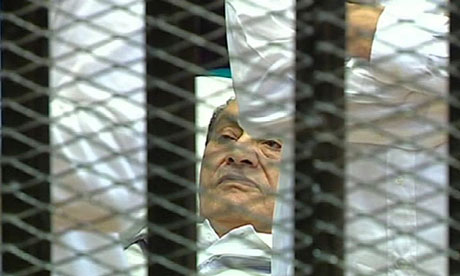The image of a caged and supine Mubarak is truly revolutionary –

An old man lies on a stretcher in a cage. It is not edifying. It is a carnival image from the bloody past of revolution, that augurs ill for the fate of Egypt's democratic rising. Hosni Mubarak has appeared at his trial supine. Immediately, people who had waited months for these pictures were tweeting their suspicion of the supposed medical necessity for him to appear in this way. But he is 83 years old. He stands, or rather lies down, alongside his sons – also pictured caged. They are charged with profiting from their father's rule, but Hosni Mubarak faces charges that include ordering the killing of protesters, and he may face the death penalty. He rolls his head feebly, raises a hand to his face, appears dead-eyed. All over Egypt, people gather around TV screens to see these pitiful pictures. This is a truly revolutionary moment, in the darkest tradition.
It is impossible to overstate the visual and spectacular nature of revolution. From the first time a crowd surges into a public square to the last cannonade, revolutions live and die by the image. A revolution is a moment when politics becomes ecstatic, symbolic, and existential. The usual slow routines of news and debate suddenly speed up, and the fastest form of communication is the visual image. The first phase of the Egyptian revolution began with the image of that great people's gathering on Tahrir Square; the second has begun with these pictures of a fallen tyrant. And this is where it gets eerie.
Many supporters of the revolution see this as a moment of victory, of symbolic justice. In a climate of stalled change and fermenting summer frustrations, it seems that at last something is happening. But if you look at the iconography – the visual history – of revolution, the image of Mubarak caged becomes more disturbing. In London in 1649, Charles I steps out of a window of the Banqueting House on to a scaffold where the axeman waits. As his head falls, the crowd is dead silent. In Paris in 1793, Louis XVI of France goes to the guillotine and instead of that silence in Whitehall this spectacle is greeted by cries of joy from a crowd of 80,000 who rush to dip their fingers in the dead king's blood. In Russia in 1918 the deposedRomanovs are told to assemble for a family photograph, then shot.
It is the French revolution above all that made a spectacle of revenge. Louis XVI's execution was commemorated with an official print showing his severed head, dripping blood. The revolutionary artist Jacques-Louis David drew a sketch portrait of Marie-Antoinette going to the guillotine – which might be compared with Mubarak on his stretcher, his eyes bleak and empty.
Over the top? Mubarak is getting an open trial, you may say, which is more than people killed in the uprising got. Yet Charles I was tried, as was Louis XVI. Perhaps Mubarak is faking illness. It does not really matter. Feasting on images of fallen tyrants is never healthy. What the English revolution of the 1640s shares with the French and Russian revolutions is that none of them led to stable democratic governments.
By contrast, every revolution that has ever led to a happy democratic outcome has avoided the spectacle of retribution. The defining image of the American revolution is not a severed head – the American army was hardly likely to invade England and arrest George III – but a group of men signing the declaration of independence. Europe in 1989 means a happy crowd streaming across the Berlin Wall – not some pathetic portrait of a dictator in the dock.
It is not sentimental pity for an old man on trial that should make us fear the image of Mubarak in his cage. It is the disturbing echoes of images of revolutionary violence from history.
A revolution is a moment of immense psychic release, and the psyche speaks in images, not words. But the collective psyche – like the individual psyche – is full of hidden dangers, base passions, Dionysian drives. The image of Tahrir Square transfixed the world. But that of the fallen Mubarak speaks to the iconography of the guillotine and the tumbril and the moments when nations soak themselves in dreams of parricide – and, if they are not careful, fratricide.
http://www.guardian.co.uk/commentisfree/series/framing-the-debate
No comments:
Post a Comment